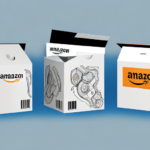Comparing Amazon FBM and FBA: Which One Is Right for Your Business?
As an Amazon seller, choosing between Fulfillment by Merchant (FBM) and Fulfillment by Amazon (FBA) is crucial for your business's success. Both options offer unique advantages and potential drawbacks. This comprehensive guide delves into the differences between FBM and FBA, providing data-driven insights and expert recommendations to help you make an informed decision.
Understanding Amazon FBM and FBA
FBM and FBA are two primary fulfillment methods offered by Amazon, each catering to different business needs.
What is Fulfillment by Merchant (FBM)?
With FBM, you, the seller, are responsible for storing, packaging, and shipping your products directly to customers. This method offers greater control over your inventory and shipping processes.
What is Fulfillment by Amazon (FBA)?
FBA allows Amazon to handle storage, packaging, and shipping of your products. Additionally, FBA products are eligible for Amazon Prime, enhancing visibility and appeal to millions of Prime members.
Key Differences Between FBM and FBA
Understanding the fundamental differences between FBM and FBA is essential for optimizing your business operations.
Control Over Inventory
- FBM: Complete control over inventory management, allowing for personalized packaging and branding.
- FBA: Amazon manages inventory storage, reducing the need for your own storage solutions.
Cost Structure
- FBM: You bear all shipping and handling costs, which can be more cost-effective for smaller sellers.
- FBA: Amazon charges storage and fulfillment fees, which may be offset by increased sales and Amazon Prime eligibility.
Pros and Cons of Amazon FBM
FBM offers several benefits and challenges that can impact your business strategy.
Advantages of FBM
- Full control over packaging and shipping processes.
- Potential for customized branding and customer experience.
- No additional fees beyond standard shipping costs.
Disadvantages of FBM
- Requires significant time and resources to manage fulfillment.
- Limited access to Amazon Prime customers.
- Responsibility for handling customer service and returns.
Pros and Cons of Amazon FBA
FBA provides several advantages that can streamline your business operations, along with some drawbacks.
Advantages of FBA
- Eligibility for Amazon Prime, increasing product visibility and sales.
- Amazon handles storage, packaging, shipping, and customer service.
- Access to Amazon's global fulfillment network, enabling international sales.
Disadvantages of FBA
- Additional fees for storage and fulfillment can impact profit margins.
- Less control over packaging and shipping processes.
- Potential for long-term storage fees if inventory doesn't move quickly.
Factors to Consider When Choosing Between FBM and FBA
Selecting the right fulfillment method depends on various aspects of your business.
Business Size and Scale
Small businesses with limited inventory may benefit from FBM, while larger businesses might find FBA more scalable and efficient.
Product Type and Handling Requirements
Products that are fragile or require special handling may be better suited for FBA's specialized facilities, whereas unique or customized products might be ideal for FBM.
Budget and Cost Analysis
Evaluate the costs associated with each fulfillment method, including fees, shipping costs, and potential sales increases. Tools like Amazon's FBA Calculator can assist in this analysis.
Setting Up Amazon FBM for Your Business
Launching FBM involves several steps to ensure seamless order fulfillment.
Creating an Amazon Seller Account
Start by registering for an Amazon seller account and selecting the FBM option during setup.
Configuring Shipping Settings
Define your shipping rates, delivery options, and handling times to set clear expectations for customers.
Managing Inventory and Orders
Implement a reliable system for tracking inventory levels and processing orders promptly to maintain customer satisfaction.
Setting Up Amazon FBA for Your Business
Establishing FBA requires coordination with Amazon's fulfillment centers.
Sending Inventory to Amazon Warehouses
Prepare and ship your products to Amazon's designated fulfillment centers, adhering to their packaging and labeling guidelines.
Creating FBA Listings
Optimize your product listings for FBA by highlighting benefits like Prime eligibility and fast shipping.
Managing FBA Account Settings
Set up your pricing, shipping preferences, and return policies within your FBA account to streamline operations.
Cost Effectiveness of FBM vs. FBA
Analyzing costs is vital to determine which fulfillment method aligns with your financial goals.
FBM Cost Analysis
FBM generally has lower upfront costs, making it suitable for businesses with tight budgets. However, shipping and handling expenses can accumulate as sales increase.
FBA Cost Analysis
While FBA involves higher fees, the potential for increased sales and reduced time spent on fulfillment can make it more cost-effective in the long run.
Efficiency in Shipping and Handling
Efficiency impacts customer satisfaction and repeat business.
FBM Efficiency
Requires robust logistics management to ensure timely shipping, which can be challenging without established processes.
FBA Efficiency
Leveraging Amazon's extensive fulfillment network ensures fast and reliable shipping, enhancing the customer experience.
Customer Service Implications
Customer service quality can significantly affect your reputation and sales.
FBM Customer Service
Handles all customer inquiries, returns, and refunds personally, allowing for personalized service but requiring dedicated resources.
FBA Customer Service
Amazon manages customer service, providing consistent and professional support, though with less personalized interaction from your end.
The Impact on Sales and Revenue
Choosing the right fulfillment method can directly influence your business's growth and profitability.
FBM Impact
Offers flexibility and control, potentially leading to higher margins if managed efficiently, but may limit scalability.
FBA Impact
Enhances product visibility and accessibility through Amazon Prime, often resulting in increased sales and revenue.
Case Studies: Success Stories with FBM and FBA
Real-world examples illustrate the effectiveness of each fulfillment method.
Successful FBM Implementation
A small business specializing in handcrafted jewelry successfully used FBM to maintain high-quality packaging and personalized customer interactions, fostering strong customer loyalty and positive reviews.
Successful FBA Implementation
A large electronics retailer leveraged FBA to handle high order volumes and expand globally, benefiting from Amazon's efficient logistics and increased Prime visibility to boost sales.
Conclusion
Deciding between FBM and FBA depends on your business's unique needs, resources, and goals. By thoroughly evaluating the pros and cons, cost structures, and operational requirements of each method, you can choose the fulfillment option that best supports your Amazon business's growth and success.
For more insights and tools to optimize your Amazon selling strategy, visit our resources at ShipScience.




















